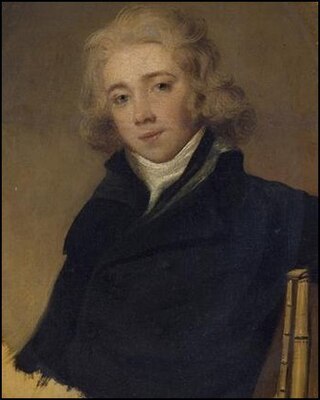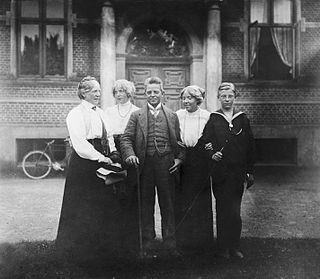Related Research Articles
Robert Wilfred Levick Simpson was an English composer, as well as a long-serving BBC producer and broadcaster.

A string orchestra is an orchestra consisting solely of a string section made up of the bowed strings used in Western Classical music. The instruments of such an orchestra are most often the following: the violin, which is divided into first and second violin players, the viola, the cello, and usually, but not always, the double bass.
The Piano Quintet in F minor, Op. 34, by Johannes Brahms was completed during the summer of 1864 and published in 1865. It was dedicated to Her Royal Highness Princess Anna of Hesse. As with most piano quintets composed after Robert Schumann's Piano Quintet (1842), it is written for piano and string quartet.

The Octet in F major, D. 803 was composed by Franz Schubert in March 1824. It was commissioned by the renowned clarinetist Ferdinand Troyer and came from the same period as two of Schubert's other major chamber works, the 'Rosamunde' and 'Death and the Maiden' string quartets.

Bernhard Heinrich Romberg was a German cellist and composer.

The String Quartet No. 19 in C Major, K. 465 by Wolfgang Amadeus Mozart, nicknamed "Dissonance" on account of its unusual slow introduction, is perhaps the most famous of his quartets.

Hyacinthe Jadin was a French composer who came from a musical family. His uncle Georges Jadin was a composer in Versailles and Paris, along with his father Jean Jadin, who had played bassoon for the French Royal Orchestra. He was one of five musical brothers, the best known of whom was Louis-Emmanuel Jadin.
The six String Quartets, Op. 76, by Joseph Haydn were composed in 1797 or 1798 and dedicated to the Hungarian count Joseph Georg von Erdődy (1754–1824). They form the last complete set of string quartets that Haydn composed. At the time of the commission, Haydn was employed at the court of Prince Nicolaus Esterházy II and was composing the oratorio The Creation as well as Princess Maria Hermenegild Esterházy's annual mass.

Franz Ries was a Romantic German violinist and composer, son of Hubert Ries. He studied at the Paris Conservatory. He also worked in the publishing business.
The String Quartet No. 2 in A minor, Op. 13, was composed by Felix Mendelssohn in 1827. Written when he was 18 years old, it was, despite its official number, Mendelssohn's first mature string quartet. One of Mendelssohn's most passionate works, the A minor Quartet is one of the earliest and most significant examples of cyclic form in music.
An organ concerto is an orchestral piece of music in which a pipe organ soloist is accompanied by an an orchestra, although some works exist with the name "concerto" which are for organ alone.

The six string quartets Op. 20 by Joseph Haydn are among the works that earned Haydn the sobriquet "the father of the string quartet". The quartets are considered a milestone in the history of composition; in them, Haydn develops compositional techniques that were to define the medium for the next 200 years.

The Piano Quartet No. 1 in G minor, Op. 25, was composed by Johannes Brahms between 1856 and 1861. It was premiered in 1861 in Hamburg, with Clara Schumann at the piano. It was also played in Vienna on 16 November 1862, with Brahms himself at the piano supported by members of the Hellmesberger Quartet. Like most piano quartets, it is scored for piano, violin, viola, and cello.
Carl Nielsen's String Quartet No. 1 in G minor, Opus 13, was first performed privately on 18 December 1889 in Copenhagen. It was the first of Nielsen's four string quartets in the official series.

Carl Nielsen's String Quartet No. 4 in F major or Quartet for Two Violins, Viola and Cello in F major, Opus 44, was composed between February and July 1906. The last of Nielsen's four string quartets in the official series, its first public performance took place on 30 November 1907 in Copenhagen.
Carl Nielsen's String Quartet No. 3 in E-flat major or Quartet for Two Violins, Viola and Cello in E-flat major, Opus 14, was composed in 1897 and 1898. The third of Nielsen's four string quartets in the official series, it was first performed privately in Vor Forening on 1 May 1899 with Anton Svendsen, Ludvig Holm, Frederik Marke and Ejler Jensen as performers.
Variations on a Theme by Tchaikovsky, Op. 35a, a piece for string orchestra by Anton Arensky, started out as the slow movement of his String Quartet No. 2 in A minor, Op. 35, for the unusual scoring of violin, viola, and 2 cellos. It was written in 1894, the year after the death of Pyotr Ilyich Tchaikovsky, in a tribute to that composer. It is based on the theme from the song "Legend", the fifth of Tchaikovsky's Sixteen Children's Songs, Op. 54.

The String Quartets, Op. 50, were composed by Joseph Haydn in 1787. The set of six quartets was dedicated to King Frederick William II of Prussia. For this reason the set is commonly known as the Prussian Quartets. Haydn sold the set to the Viennese firm Artaria and, without Artaria's knowledge, to the English publisher William Forster. Forster published it as Haydn's Opus 44. Haydn's autograph manuscripts for Nos. 3 to 6 of the set were discovered in Melbourne, Australia, in 1982.

The Piano Quartets, WoO 36, by Ludwig van Beethoven are a set of three piano quartets, completed in 1785 when the composer was aged 14. They are scored for piano, violin, viola and cello. He composed a quartet in C major, another in E-flat major, and a third in D major. They were first published posthumously in 1828, however numbered in a different order: Piano Quartet No. 1 in E-flat major, Piano Quartet No. 2 in D major, and Piano Quartet No. 3 in C major.
References
- 1 2 3 4 Elly Bruunshuus Petersen, "Quartet for Two Violins, Viola and Cello in F minor, Opus 5" in "Chamber Music", Carl Nielsen Edition Archived 2010-04-09 at the Wayback Machine . Royal Danish Library. Retrieved 30 October 2010.
- ↑ "Carl Nielsen: String Quartet No.2 in f minor, Op.5", Edition Silvertrust. Retrieved 30 October 2010.